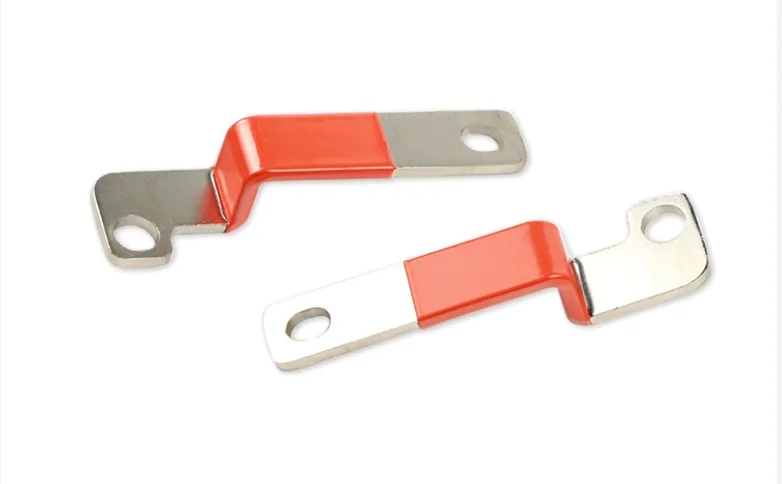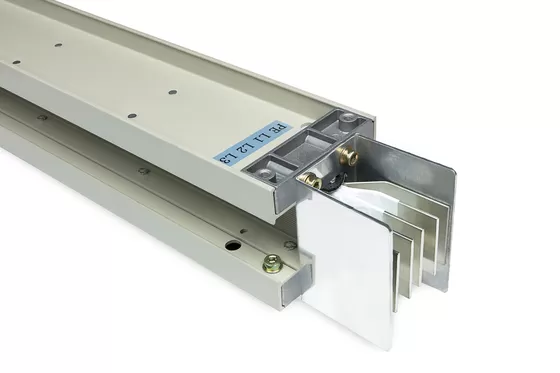A busbar is a bare or insulated conductor that distributes electrical power within a single enclosure, while a busway is a complete prefabricated system of enclosed conductors with protective housing designed for power distribution across longer distances and multiple connection points.
Understanding the difference between busbars and busways is critical for electrical engineers, contractors, and facility managers making power distribution decisions. This guide provides comprehensive technical comparisons, safety requirements, and selection criteria to help you choose the right solution for your specific application.
What is a Busbar? Complete Definition and Technical Overview
A busbar is a metallic conductor, typically made of copper or aluminum, designed to carry large electrical currents within electrical panels, switchgear, and distribution equipment. Busbars serve as central collection points where multiple electrical circuits connect to distribute power throughout a facility.
Key Technical Characteristics:
- Anyag: Primarily copper (higher conductivity) or aluminum (cost-effective)
- Konfiguráció: Flat strips, rectangular bars, or tubular conductors
- Jelenlegi értékelés: 100 amperes to over 6,000 amperes
- Telepítés helye: Inside electrical enclosures and panelboards
- Védelem: Relies on enclosure for environmental protection
What is a Busway? Complete Definition and System Overview
A busway is a prefabricated electrical distribution system consisting of busbars enclosed in a protective metal housing with standardized connection points called tap-off boxes. Busways provide a modular, flexible approach to power distribution that can be easily modified or expanded.
Key System Components:
- Conductor Assembly: Copper or aluminum busbars with proper phase spacing
- Protective Housing: Grounded metal enclosure providing environmental protection
- Tap-Off Connections: Standardized connection points for branch circuits
- Support Systems: Mounting brackets and suspension hardware
- Jelenlegi értékelés: 225 amperes to 5,000+ amperes for industrial applications
Busbar vs Busway: Comprehensive Technical Comparison
| Jellemző | Gyűjtősínes | Busway |
|---|---|---|
| Meghatározás | Bare or insulated conductor within enclosure | Complete prefabricated distribution system |
| Telepítés helye | Inside panels and switchgear | Open installation along walls/ceilings |
| Rugalmasság | Fixed installation, difficult to modify | Modular design, easily reconfigured |
| Jelenlegi tartomány | 100A – 6,000A+ | 225A – 5,000A+ |
| Cost (Initial) | Alacsonyabb anyagköltség | Magasabb kezdeti befektetés |
| Labor Requirements | High field installation time | Csökkentett telepítési idő |
| Tap-Off Capability | Limited connection points | Multiple standardized tap points |
| Kódkövetelmények | NEC Article 408 (panels) | NEC Article 368 (busways) |
| Környezetvédelem | Depends on enclosure | Integral weatherproof housing |
| Modification Ease | Requires panel shutdown | Hot tap capability available |
| Helyigény | Compact within enclosures | Requires dedicated routing space |
Key Differences Between Busbars and Busways
1. Installation Method and Flexibility
Sínpárok require field fabrication and installation within electrical enclosures. Once installed, modifications require significant electrical work and potential system shutdowns. This makes busbars ideal for permanent installations with fixed power requirements.
Busways arrive as prefabricated sections that bolt together using standardized connections. The modular design allows for easy reconfiguration, expansion, or relocation without major electrical work, making them perfect for dynamic industrial environments.
2. Power Distribution Philosophy
Sínpárok serve as central collection points within electrical equipment, connecting multiple branch circuits to main power sources. They function as the backbone of traditional panelboard and switchgear designs.
Busways act as electrical highways, carrying power from main distribution points to various locations throughout a facility. They replace traditional cable and conduit runs for high-amperage applications.
3. Connection and Tap-Off Capabilities
Sínpárok offer limited connection points determined during initial design and installation. Adding new connections typically requires panel modifications and system downtime.
Busways provide multiple tap-off points along their length, with some systems offering “hot tap” capability for adding connections while energized (when performed by qualified personnel following proper safety procedures).
Applications and Use Cases: When to Choose Each System
Optimal Busbar Applications
- Ipari vezérlőpanelek
- Motor control centers requiring compact design
- Process control systems with fixed configurations
- UL-listed panel assemblies requiring standard compliance
- Switchgear Applications
- High-voltage distribution equipment
- Utility interconnections requiring maximum current density
- Critical power systems prioritizing reliability over flexibility
- Data Center Power Distribution
- PDU internal connections requiring space efficiency
- Critical systems requiring UL-listed assemblies
- High-density installations with limited modification needs
Ideal Busway Applications
- Gyártó létesítmények
- Production lines requiring flexible power distribution
- Clean room environments needing easy reconfiguration
- Industrial plants with changing equipment layouts
- Kereskedelmi épületek
- Office spaces with evolving tenant requirements
- Retail environments requiring frequent reconfigurations
- Educational facilities adapting to changing technology needs
- Data Centers and Server Farms
- Overhead power distribution reducing floor space usage
- Scalable infrastructure supporting rapid expansion
- Hot-aisle containment systems requiring accessible power
Biztonsági követelmények és a szabályzatoknak való megfelelés
Nemzeti Villamos Szabályzat (NEC) Követelmények
Busbar Installations (NEC Article 408)
- Must be enclosed in grounded metal cabinets
- Require proper phase spacing per voltage rating
- Need appropriate short-circuit current ratings
- Must include proper grounding and bonding
Busway Systems (NEC Article 368)
- Require UL-listed assemblies for commercial installations
- Must include proper support spacing (typically 5-foot intervals)
- Need appropriate overcurrent protection at origin point
- Require grounding conductor throughout system length
⚠️ BIZTONSÁGI FIGYELMEZTETÉS: All electrical work involving busbars and busways must be performed by qualified electricians following NFPA 70E standards. High-amperage systems present serious arc flash and electrocution hazards.
Installation Safety Considerations
Critical Safety Factors:
- Arc Flash Assessment: Required for all busbar and busway work
- Proper PPE: Category-rated clothing and equipment based on incident energy
- Kizárás/Kitáblázás: Mandatory for all maintenance and modification work
- Qualified Personnel: Only licensed electricians should perform installations
- Kód Megfelelés: Local electrical codes may have additional requirements
Selection Criteria: How to Choose Between Busbars and Busways
Choose Busbars When:
- Fixed Installation Requirements
- Permanent power distribution with no anticipated changes
- Space-constrained applications requiring maximum compactness
- UL-listed panel assemblies required for insurance or code compliance
- Cost-Sensitive Projects
- Lower initial material costs are priority
- Simple point-to-point power distribution needs
- High current density applications with limited connection points
- Traditional Electrical Infrastructure
- Integration with existing panelboard systems
- Replacement of existing busbar assemblies
- Applications requiring standard electrical panel form factors
Choose Busways When:
- Flexibility and Future Expansion Needs
- Anticipated layout changes or equipment relocations
- Growing facilities requiring scalable power infrastructure
- Multi-tenant buildings with changing power requirements
- High-Current Distribution Over Distance
- Power feeds exceeding 400 amperes over 50+ feet
- Multiple tap-off points along distribution path
- Overhead installation preferred over floor-level panels
- Rapid Installation Requirements
- Projects with tight construction schedules
- Retrofit installations minimizing existing system disruption
- Modular construction requiring standardized connections
Expert Tips for Optimal Selection and Implementation
💡 Professional Selection Guidelines
- Conduct Thorough Load Analysis: Calculate not just current requirements but also future expansion needs. Busways excel when growth potential exceeds 25% of initial capacity.
- Evaluate Total Cost of Ownership: While busways have higher initial costs, consider reduced installation time, easier modifications, and improved system flexibility over 20+ year lifespan.
- Vegye figyelembe a környezeti tényezőket: Busways with appropriate NEMA ratings handle harsh environments better than enclosed busbars requiring additional protection.
- Plan for Maintenance Access: Busways provide superior maintenance access compared to densely packed panelboards, reducing long-term service costs.
⚠️ Critical Safety Reminders
- Never Compromise on Safety Standards: Both busbars and busways carry lethal voltages and currents. Always follow NFPA 70E requirements and use qualified personnel.
- Verify Proper Grounding: Inadequate grounding in high-current systems creates serious safety hazards. Ensure continuous equipment grounding throughout system.
- Maintain Proper Documentation: Keep accurate as-built drawings showing conductor arrangements, ratings, and connection points for future maintenance and modifications.
Quick Reference: Specification Comparison Chart
| Specifikáció | Typical Busbar Range | Typical Busway Range |
|---|---|---|
| Jelenlegi értékelés | 100A – 6,000A | 225A – 5,000A |
| Feszültség Értékelés | 120V – 600V | 120V – 600V |
| Anyagi lehetőségek | Copper/Aluminum | Copper/Aluminum |
| Telepítési költség | $2-8 per amp | $8-15 per amp |
| Modification Cost | High (panel work) | Low (plug-in taps) |
| Tipikus élettartam | 30+ years | 25+ years |
| Átfutási idő | 2-6 weeks | 4-8 weeks |
Gyakori problémák elhárítása
Busbar Installation Problems
Túlmelegedési problémák
- Ok: Inadequate conductor sizing or poor connections
- Megoldás: Verify calculations per NEC Table 310.15(B)(16) and inspect all connections
Térbeli korlátok
- Ok: Insufficient clearances for NEC requirements
- Megoldás: Review NEC Table 408.5 for minimum spacing requirements
Busway System Challenges
Csatlakozási problémák
- Ok: Misaligned sections or contaminated contact surfaces
- Megoldás: Follow manufacturer’s torque specifications and use contact cleaner
Voltage Drop Issues
- Ok: Excessive system length without proper sizing
- Megoldás: Calculate voltage drop per NEC Chapter 9, Table 9 and upsize conductors if needed
Szakmai telepítési ajánlások
When to Consult Electrical Engineers
Complex Systems Requiring Design Analysis
- High-fault current applications exceeding 65kA
- Critical power systems requiring redundancy
- Integration with existing electrical infrastructure
Code Compliance Questions
- Local amendments to NEC requirements
- Special occupancy requirements (healthcare, hazardous locations)
- Utility interconnection standards
Recommended Certification Requirements
Installer Qualifications
- Licensed journeyman electrician minimum
- NFPA 70E training certification
- Manufacturer-specific training for busway systems
Gyakran Ismételt Kérdések
What makes busways more expensive than busbars initially?
Busways cost more initially because they include protective housing, standardized connections, and factory assembly. However, they often provide better long-term value through reduced installation time and easier modifications.
Can you mix different manufacturers’ busway components?
No, busway systems are not interchangeable between manufacturers. Each system uses proprietary connection methods and specifications. Always use components from the same manufacturer for proper fit and UL listing compliance.
How do you determine the right current rating for your application?
Calculate your total connected load, apply appropriate demand factors per NEC Article 220, and add 25% for future expansion. Always consult with qualified electrical engineers for complex calculations.
What are the maintenance requirements for each system?
Busbars require periodic inspection within enclosed panels, checking for loose connections and overheating. Busways need regular cleaning of housing, connection inspection, and verification of support integrity.
Can busways be installed outdoors?
Yes, busways are available with appropriate NEMA ratings for outdoor installation (NEMA 3R, 4, 4X). Ensure proper weatherproofing at all connection points and follow manufacturer’s installation guidelines.
How long do busbar and busway systems typically last?
Both systems can last 25-30+ years with proper maintenance. Busways may have slightly shorter lifespans due to environmental exposure, while enclosed busbars benefit from protection within electrical panels.
What safety training is required for working on these systems?
All personnel must complete NFPA 70E electrical safety training appropriate for their qualification level. Arc flash assessments are mandatory, and proper PPE must be worn based on incident energy calculations.
Are there special considerations for seismic zones?
Yes, both systems require proper seismic bracing per local building codes. Busways need additional support points and flexible connections at building joints. Consult structural engineers for seismic zone installations.
Expert Conclusion and Next Steps
Choosing between busbars and busways depends on your specific application requirements, future expansion plans, and budget considerations. Busbars excel in permanent, space-constrained installations where cost is paramount, while busways provide superior flexibility and ease of modification for dynamic environments.
For complex power distribution decisions, always consult with qualified electrical engineers who can perform detailed load calculations, fault current analysis, and code compliance verification. Proper selection and installation of these critical power distribution components ensures safe, reliable electrical systems that serve your facility for decades.
Ready to implement the right power distribution solution? Contact licensed electrical professionals to evaluate your specific requirements and develop detailed specifications that meet all safety codes and performance objectives.




